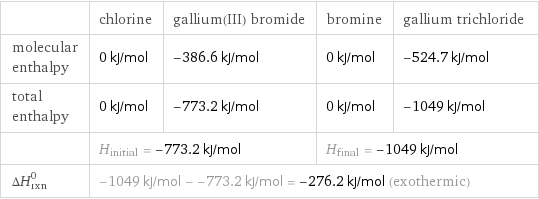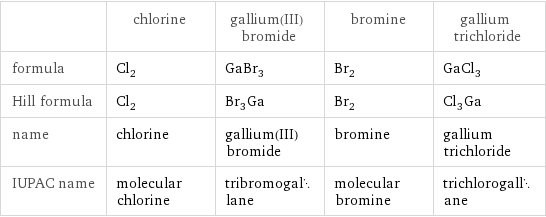Input interpretation

Cl_2 chlorine + GaBr_3 gallium(III) bromide ⟶ Br_2 bromine + GaCl_3 gallium trichloride
Balanced equation

Balance the chemical equation algebraically: Cl_2 + GaBr_3 ⟶ Br_2 + GaCl_3 Add stoichiometric coefficients, c_i, to the reactants and products: c_1 Cl_2 + c_2 GaBr_3 ⟶ c_3 Br_2 + c_4 GaCl_3 Set the number of atoms in the reactants equal to the number of atoms in the products for Cl, Br and Ga: Cl: | 2 c_1 = 3 c_4 Br: | 3 c_2 = 2 c_3 Ga: | c_2 = c_4 Since the coefficients are relative quantities and underdetermined, choose a coefficient to set arbitrarily. To keep the coefficients small, the arbitrary value is ordinarily one. For instance, set c_2 = 1 and solve the system of equations for the remaining coefficients: c_1 = 3/2 c_2 = 1 c_3 = 3/2 c_4 = 1 Multiply by the least common denominator, 2, to eliminate fractional coefficients: c_1 = 3 c_2 = 2 c_3 = 3 c_4 = 2 Substitute the coefficients into the chemical reaction to obtain the balanced equation: Answer: | | 3 Cl_2 + 2 GaBr_3 ⟶ 3 Br_2 + 2 GaCl_3
Structures

+ ⟶ +
Names

chlorine + gallium(III) bromide ⟶ bromine + gallium trichloride
Reaction thermodynamics
Enthalpy

| chlorine | gallium(III) bromide | bromine | gallium trichloride molecular enthalpy | 0 kJ/mol | -386.6 kJ/mol | 0 kJ/mol | -524.7 kJ/mol total enthalpy | 0 kJ/mol | -773.2 kJ/mol | 0 kJ/mol | -1049 kJ/mol | H_initial = -773.2 kJ/mol | | H_final = -1049 kJ/mol | ΔH_rxn^0 | -1049 kJ/mol - -773.2 kJ/mol = -276.2 kJ/mol (exothermic) | | |
Gibbs free energy

| chlorine | gallium(III) bromide | bromine | gallium trichloride molecular free energy | 0 kJ/mol | -359.8 kJ/mol | 0 kJ/mol | -454.8 kJ/mol total free energy | 0 kJ/mol | -719.6 kJ/mol | 0 kJ/mol | -909.6 kJ/mol | G_initial = -719.6 kJ/mol | | G_final = -909.6 kJ/mol | ΔG_rxn^0 | -909.6 kJ/mol - -719.6 kJ/mol = -190 kJ/mol (exergonic) | | |
Equilibrium constant
![Construct the equilibrium constant, K, expression for: Cl_2 + GaBr_3 ⟶ Br_2 + GaCl_3 Plan: • Balance the chemical equation. • Determine the stoichiometric numbers. • Assemble the activity expression for each chemical species. • Use the activity expressions to build the equilibrium constant expression. Write the balanced chemical equation: 3 Cl_2 + 2 GaBr_3 ⟶ 3 Br_2 + 2 GaCl_3 Assign stoichiometric numbers, ν_i, using the stoichiometric coefficients, c_i, from the balanced chemical equation in the following manner: ν_i = -c_i for reactants and ν_i = c_i for products: chemical species | c_i | ν_i Cl_2 | 3 | -3 GaBr_3 | 2 | -2 Br_2 | 3 | 3 GaCl_3 | 2 | 2 Assemble the activity expressions accounting for the state of matter and ν_i: chemical species | c_i | ν_i | activity expression Cl_2 | 3 | -3 | ([Cl2])^(-3) GaBr_3 | 2 | -2 | ([GaBr3])^(-2) Br_2 | 3 | 3 | ([Br2])^3 GaCl_3 | 2 | 2 | ([GaCl3])^2 The equilibrium constant symbol in the concentration basis is: K_c Mulitply the activity expressions to arrive at the K_c expression: Answer: | | K_c = ([Cl2])^(-3) ([GaBr3])^(-2) ([Br2])^3 ([GaCl3])^2 = (([Br2])^3 ([GaCl3])^2)/(([Cl2])^3 ([GaBr3])^2)](../image_source/b980544f46962fb2f6deaa97bf668220.png)
Construct the equilibrium constant, K, expression for: Cl_2 + GaBr_3 ⟶ Br_2 + GaCl_3 Plan: • Balance the chemical equation. • Determine the stoichiometric numbers. • Assemble the activity expression for each chemical species. • Use the activity expressions to build the equilibrium constant expression. Write the balanced chemical equation: 3 Cl_2 + 2 GaBr_3 ⟶ 3 Br_2 + 2 GaCl_3 Assign stoichiometric numbers, ν_i, using the stoichiometric coefficients, c_i, from the balanced chemical equation in the following manner: ν_i = -c_i for reactants and ν_i = c_i for products: chemical species | c_i | ν_i Cl_2 | 3 | -3 GaBr_3 | 2 | -2 Br_2 | 3 | 3 GaCl_3 | 2 | 2 Assemble the activity expressions accounting for the state of matter and ν_i: chemical species | c_i | ν_i | activity expression Cl_2 | 3 | -3 | ([Cl2])^(-3) GaBr_3 | 2 | -2 | ([GaBr3])^(-2) Br_2 | 3 | 3 | ([Br2])^3 GaCl_3 | 2 | 2 | ([GaCl3])^2 The equilibrium constant symbol in the concentration basis is: K_c Mulitply the activity expressions to arrive at the K_c expression: Answer: | | K_c = ([Cl2])^(-3) ([GaBr3])^(-2) ([Br2])^3 ([GaCl3])^2 = (([Br2])^3 ([GaCl3])^2)/(([Cl2])^3 ([GaBr3])^2)
Rate of reaction
![Construct the rate of reaction expression for: Cl_2 + GaBr_3 ⟶ Br_2 + GaCl_3 Plan: • Balance the chemical equation. • Determine the stoichiometric numbers. • Assemble the rate term for each chemical species. • Write the rate of reaction expression. Write the balanced chemical equation: 3 Cl_2 + 2 GaBr_3 ⟶ 3 Br_2 + 2 GaCl_3 Assign stoichiometric numbers, ν_i, using the stoichiometric coefficients, c_i, from the balanced chemical equation in the following manner: ν_i = -c_i for reactants and ν_i = c_i for products: chemical species | c_i | ν_i Cl_2 | 3 | -3 GaBr_3 | 2 | -2 Br_2 | 3 | 3 GaCl_3 | 2 | 2 The rate term for each chemical species, B_i, is 1/ν_i(Δ[B_i])/(Δt) where [B_i] is the amount concentration and t is time: chemical species | c_i | ν_i | rate term Cl_2 | 3 | -3 | -1/3 (Δ[Cl2])/(Δt) GaBr_3 | 2 | -2 | -1/2 (Δ[GaBr3])/(Δt) Br_2 | 3 | 3 | 1/3 (Δ[Br2])/(Δt) GaCl_3 | 2 | 2 | 1/2 (Δ[GaCl3])/(Δt) (for infinitesimal rate of change, replace Δ with d) Set the rate terms equal to each other to arrive at the rate expression: Answer: | | rate = -1/3 (Δ[Cl2])/(Δt) = -1/2 (Δ[GaBr3])/(Δt) = 1/3 (Δ[Br2])/(Δt) = 1/2 (Δ[GaCl3])/(Δt) (assuming constant volume and no accumulation of intermediates or side products)](../image_source/395e6b5e1278a52df9444310da528d79.png)
Construct the rate of reaction expression for: Cl_2 + GaBr_3 ⟶ Br_2 + GaCl_3 Plan: • Balance the chemical equation. • Determine the stoichiometric numbers. • Assemble the rate term for each chemical species. • Write the rate of reaction expression. Write the balanced chemical equation: 3 Cl_2 + 2 GaBr_3 ⟶ 3 Br_2 + 2 GaCl_3 Assign stoichiometric numbers, ν_i, using the stoichiometric coefficients, c_i, from the balanced chemical equation in the following manner: ν_i = -c_i for reactants and ν_i = c_i for products: chemical species | c_i | ν_i Cl_2 | 3 | -3 GaBr_3 | 2 | -2 Br_2 | 3 | 3 GaCl_3 | 2 | 2 The rate term for each chemical species, B_i, is 1/ν_i(Δ[B_i])/(Δt) where [B_i] is the amount concentration and t is time: chemical species | c_i | ν_i | rate term Cl_2 | 3 | -3 | -1/3 (Δ[Cl2])/(Δt) GaBr_3 | 2 | -2 | -1/2 (Δ[GaBr3])/(Δt) Br_2 | 3 | 3 | 1/3 (Δ[Br2])/(Δt) GaCl_3 | 2 | 2 | 1/2 (Δ[GaCl3])/(Δt) (for infinitesimal rate of change, replace Δ with d) Set the rate terms equal to each other to arrive at the rate expression: Answer: | | rate = -1/3 (Δ[Cl2])/(Δt) = -1/2 (Δ[GaBr3])/(Δt) = 1/3 (Δ[Br2])/(Δt) = 1/2 (Δ[GaCl3])/(Δt) (assuming constant volume and no accumulation of intermediates or side products)
Chemical names and formulas

| chlorine | gallium(III) bromide | bromine | gallium trichloride formula | Cl_2 | GaBr_3 | Br_2 | GaCl_3 Hill formula | Cl_2 | Br_3Ga | Br_2 | Cl_3Ga name | chlorine | gallium(III) bromide | bromine | gallium trichloride IUPAC name | molecular chlorine | tribromogallane | molecular bromine | trichlorogallane
Substance properties

| chlorine | gallium(III) bromide | bromine | gallium trichloride molar mass | 70.9 g/mol | 309.43 g/mol | 159.81 g/mol | 176.1 g/mol phase | gas (at STP) | solid (at STP) | liquid (at STP) | solid (at STP) melting point | -101 °C | 121.5 °C | -7.2 °C | 78 °C boiling point | -34 °C | 279 °C | 58.8 °C | 225 °C density | 0.003214 g/cm^3 (at 0 °C) | 3.69 g/cm^3 | 3.119 g/cm^3 | 2.47 g/cm^3 solubility in water | | soluble | insoluble | very soluble surface tension | | | 0.0409 N/m | dynamic viscosity | | | 9.44×10^-4 Pa s (at 25 °C) |
Units
